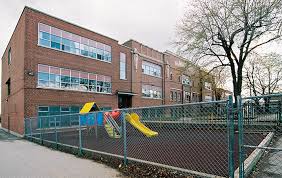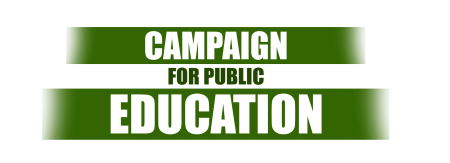These schools aren’t under capacity
 Is a school half full or half empty? That depends on how you measure. As the Toronto District School Board scrambles to name schools that are less than two-thirds full by Queen’s Park’s counting method, many are asking how good that provincial yardstick is.
Is a school half full or half empty? That depends on how you measure. As the Toronto District School Board scrambles to name schools that are less than two-thirds full by Queen’s Park’s counting method, many are asking how good that provincial yardstick is.
Education Minister Liz Sandals has given the TDSB just weeks to spell out plans for closing schools over the next three years that are under-used by the province’s reckoning — which counts only full-time K-12 students, not extras such as child care and parenting programs that may share space.
“It would be a disaster if we closed Burnhamthorpe Collegiate, for example (only 35 per cent full with teenaged students),” said trustee Chris Glover, “because the building is absolutely packed with almost 1,000 adult students going back to get high school credits. But the ministry doesn’t consider this space as being used, because they’re adults.”
Sandals has ordered the TDSB to start offloading excess space, after a damning report by veteran educator Margaret Wilson criticized trustees for dragging their heels on school closings, when 130 schools are considered less than 65 per cent full.
But when staff released the list of under-used schools Wednesday, many warned against snap decisions based on “utilization rate” numbers alone.
“I don’t think it tells the whole story,” warned trustee Ausma Malik. “The minister herself and the premier have talked about our schools as community hubs, and so many of our schools are being used in that way,” but they appear near-empty under the ministry’s formula.
“Blake St. Jr. Public School is listed as 45 per cent full, but we’ve just added French Immersion and it’s projected to grow to 86 per cent,” said trustee Jennifer Story. Eastdale Collegiate may be only 32 per cent full, but many of its students have been referred from larger schools that couldn’t meet their needs.
“Some schools focus on life skills,” said Story; “but we could lose this kind of site by strict adherence to the province’s utilization guidelines.”
An exasperated Sandals said Thursday that she realizes that being listed as under-utilized doesn’t necessarily mean it must close. But with Ontario spending more than $1 billion a year on under-utilized schools province-wide, “we need more detailed information about what their plans are (by) Feb. 13.”
Trustee Chris Tonks said the board has situations where secondary schools “are dying … and now push is coming to shove,” he said. But elementary enrolment is starting to bounce back, “and when that plays through, we are going to have to have a look at where we are going to need space,” he said.
Tonks said he’s surprised the ministry is telling the board to close schools, given the number of provincially funded child-care centres, Best Start preschool programs and family literacy centres housed in unused classrooms.
“We need to say, ‘Wait a minute — these schools aren’t under capacity,’” he said. “And if we close them, what are we going to do with all the programs (the government) is funding?”
TORONTO’S MOST ‘UNDER-UTILIZED’ SCHOOLS As the province asks the Toronto District School Board to offload excess space, here’s a look at some schools that on paper are under-used, and what actually goes on in them.
Low-enrolment high schools
Eastern Commerce Collegiate (near Danforth Ave. and Jones Ave.) Enrolment: 62 Capacity: 903 Utilization: 7 per cent Reality Check: School houses a child care centre, the TDSB’s archives, a resource centre for teachers and was the first to pilot the 10 a.m. “late start” to suit the sleepy morning teenaged brain. While it stopped accepting new students last fall, there are plans for what trustee Jennifer Story promises will be “an exciting new program at Eastern that we believe the public and the ministry will be very supportive of.”
Nelson A Boylen Collegiate (near Jane St. and Highway 401) Enrolment: 71 Capacity: 531 Utilization: 13 per cent Reality check: Two years ago, just nine students registered for Grade 9, so board staff redirected them to other schools, says local trustee Chris Tonks. Last year, Grade 9s were also redirected. Tonks said an area review “should have been started a long time ago; instead we’ve let it become so compromised” the Grade 12 students now also have to be moved. Tonks is trying to make sure a program for developmentally delayed students can remain on-site, maybe by renting out empty space “so we don’t have to move those kids.”
Vaughan Road Academy (near Oakwood Ave. and Vaughan Rd.) Enrolment: 349 Capacity: 1,179 Utilization: 30 per cent Reality check: The school has two specialized programs — International Baccalaureate (IB) and Interact, which provides flexible timetables for elite athletes or artists. It has served a number of cast members from the Canadian TV show Degrassi, says local trustee Jennifer Arp. The school, which also has a child-care centre, is also a victim of demographics, given the neighbourhood has seen a decline in the number of teens, she added.
Danforth Collegiate and Technical Institute (near Danforth Ave. and Greenwood Ave.) Enrolment: 930 Capacity: 2,118 Utilization: 44 per cent Reality check: School offers auto mechanics and culinary programs, said trustee Jennifer Story, which take more space than regular classrooms. It also has a popular math, science and technology program (“MaST”) for which applicants compete through a two-hour exam and essay, a program some suggest could be expanded.
John Polanyi Collegiate (near Allen Rd. and Lawrence Ave. W.) Enrolment: 651 Capacity: 1,410 Utilization: 46 per cent Reality check: School houses a program for expelled students that uses at least two classrooms, 10 adult English-as-a-second-language classrooms, a classroom for literacy and basic skills, space for staff training, and the North York Harvest Food Bank leases space — none of which count towards its utilization rate. “When I do go into the school, it’s a pretty busy place,” said trustee Jennifer Arp. Opened in 2011, it offers enriched programming in science, math and technology/robotics and is growing as it gets a profile in the community, Arp added.
Low-enrolment elementary schools
Kensington Community School (near Bathurst St. and College St.) Enrolment: 113 Capacity: 447 Utilization: 25 per cent Reality check: School was part of an area review just last fall that did not recommend it close, said new Trustee Ausma Malik. Kensington is expecting an influx of students from a neighboring school that is switching to French Immersion. It houses a day care, two adult English-as-a-second-language classrooms and local artists also work at the school. “It is envisioned as a community hub when it was built and the school maintains that in so many ways,” she said. A permits office with 23 staff members is also expected to move into the school.
Lucy McCormick Sr. School (near Dundas St. W. and Dupont St.) Enrolment: 67 Capacity: 171 Utilization: 39 per cent Reality check: School serves students with developmental disabilities from 12 to 21 years of age. Professional teams that support students include teachers, educational assistants, child and youth workers, blind/deaf intervenors, a horticulture instructor, continuing education staff, social workers, psychologists, speech and language, physio- and occupational therapists.
Nelson Mandela Park Public School (near Shuter St. and Parliament St.) Enrolment: 331 Capacity: 804 Utilization: 41 per cent Reality check: Stunning new building opened in 2013 after a three-year, $30-million facelift and expansion, and is likely only under-enrolled while some Regent Park students are living elsewhere during the reconstruction. The school is projected to be 102 per cent full by 2024. “In three or four years we’ll be back at capacity, with a growing mix of children from both Toronto Community Housing and market-value housing,” said principal Jason Kandankery. “No way we’re closing; I’m not worried.”
Wellesworth Jr School (near Rathburn Rd. and Highway 427) Enrolment: 169 Capacity: 330 Utilization: 51 per cent Reality Check: It may be half-empty now, but trustee Chris Glover said a new development is coming nearby with 900 new units that could generate some 200 students. “The closest school to that development is full,” said Glover, “so the closest school that has space for this new development project is Wellesworth.”
Queen Alexandra Middle School (near Queen St. E. and Broadview Ave.) Enrolment: 249 Capacity: 485 Utilization: 51 per cent Reality check: A nearby housing development in the West Don Lands will bring new families to the area, said trustee Jennifer Story, “but there are no plans yet to build a school for that area, so Queen Alexandra is being planned as the school where they will go.”
thestar.com By: Louise Brown GTA, Education Schools, Kristin Rushowy Education Reporter, With files from Robert Benzie Published on Thu Jan 29 2015

